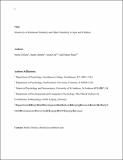Files in this item
Sensitivity to relational similarity and object similarity in apes and children
Item metadata
| dc.contributor.author | Christie, Stella | |
| dc.contributor.author | Gentner, Dedre | |
| dc.contributor.author | Call, Josep | |
| dc.contributor.author | Haun, Daniel Benjamin Moritz | |
| dc.date.accessioned | 2017-02-05T00:32:38Z | |
| dc.date.available | 2017-02-05T00:32:38Z | |
| dc.date.issued | 2016-02-22 | |
| dc.identifier | 240523958 | |
| dc.identifier | dd5fb0d6-628a-423e-a201-b37905a47d41 | |
| dc.identifier | 84959569978 | |
| dc.identifier | 000370877400029 | |
| dc.identifier.citation | Christie , S , Gentner , D , Call , J & Haun , D B M 2016 , ' Sensitivity to relational similarity and object similarity in apes and children ' , Current Biology , vol. 26 , no. 4 , pp. 531-535 . https://doi.org/10.1016/j.cub.2015.12.054 | en |
| dc.identifier.issn | 0960-9822 | |
| dc.identifier.other | ORCID: /0000-0002-8597-8336/work/37477956 | |
| dc.identifier.uri | https://hdl.handle.net/10023/10229 | |
| dc.description | This research was supported by NSF SLC Grant SBE-0541957 awarded to the Spatial Intelligence and Learning Center (SILC), the Max Planck Society, and Swarthmore Lang Sabbatical Fellowship. | en |
| dc.description.abstract | Relational reasoning is a hallmark of sophisticated cognition in humans [1, 2]. Does it exist in other primates? Despite some affirmative answers [3, 4, 5, 6, 7, 8, 9, 10, 11], there appears to be a wide gap in relational ability between humans and other primates—even other apes [1, 2]. Here, we test one possible explanation for this gap, motivated by developmental research showing that young humans often fail at relational reasoning tasks because they focus on objects instead of relations [12, 13, 14]. When asked, “duck:duckling is like tiger:?,” preschool children choose another duckling (object match) rather than a cub. If other apes share this focus on concrete objects, it could undermine their relational reasoning in similar ways. To test this, we compared great apes and 3-year-old humans’ relational reasoning on the same spatial mapping task, with and without competing object matches. Without competing object matches, both children and Pan species (chimpanzees and bonobos) spontaneously used relational similarity, albeit children more so. But when object matches were present, only children responded strongly to them. We conclude that the relational gap is not due to great apes’ preference for concrete objects. In fact, young humans show greater object focus than nonhuman apes. | |
| dc.format.extent | 727381 | |
| dc.language.iso | eng | |
| dc.relation.ispartof | Current Biology | en |
| dc.subject | RC0321 Neuroscience. Biological psychiatry. Neuropsychiatry | en |
| dc.subject | BF Psychology | en |
| dc.subject | QL Zoology | en |
| dc.subject | NDAS | en |
| dc.subject | BDC | en |
| dc.subject | R2C | en |
| dc.subject.lcc | RC0321 | en |
| dc.subject.lcc | BF | en |
| dc.subject.lcc | QL | en |
| dc.title | Sensitivity to relational similarity and object similarity in apes and children | en |
| dc.type | Journal article | en |
| dc.contributor.institution | University of St Andrews. School of Psychology and Neuroscience | en |
| dc.contributor.institution | University of St Andrews. Centre for Social Learning & Cognitive Evolution | en |
| dc.identifier.doi | 10.1016/j.cub.2015.12.054 | |
| dc.description.status | Peer reviewed | en |
| dc.date.embargoedUntil | 2017-02-04 | |
| dc.identifier.url | https://www.sciencedirect.com/science/article/pii/S0960982215015857?via%3Dihub#app2 | en |
This item appears in the following Collection(s)
Items in the St Andrews Research Repository are protected by copyright, with all rights reserved, unless otherwise indicated.

